Thanks to David Reid W6KL, I now have my first Teletype Model 28! I’ve had a number of Teletype Model 33 machines over the years, but this is my first 28. I’ve always been impressed with the 28 machines I’ve encountered at Military Radio Collectors Group meets, so I’m happy to finally add one to my collection. This one was owned by Al Tipsword W6GER (SK) before David adopted it.
This one is a KSR (Keyboard Send/Receive) unit, and it came with a Bell System teletype table which appears to have held a different machine for a long time based on the indentations in its thick felt top. A previous owner has added a power switch and fuse to the front panel, and I think that the selector magnet connector is not original. I have not yet figured out whether the beige paint job is original.
It looks pretty clean. I have not yet applied power, but it looks like it is not far from working at worst, and might just spring to life at best. Everything seems to be moving smoothly when I turn the motor by hand. I also need to determine what gears are installed. I hope that it is already configured for 45.45 baud 60 WPM operation.
David also provided me with a service manual, and a spare parts-donor typing unit.
I am new to Model 28 gear, so I would welcome any insight from experienced Model 28 folks who might be able to fill in any interesting details based of my machine.
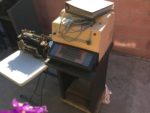
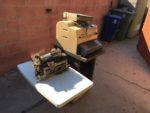
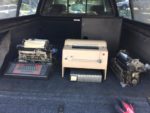
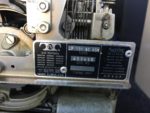
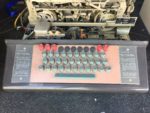
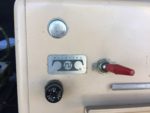

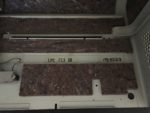
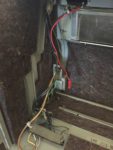
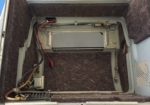
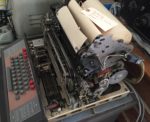
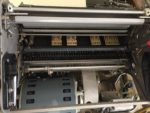
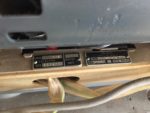
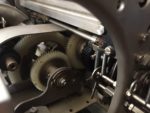
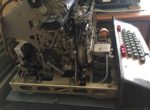
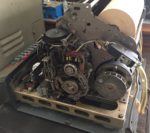
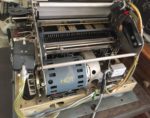
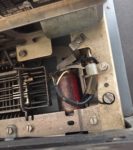
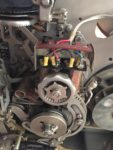
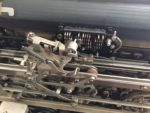

Reminiscing and drifting on the internet, I ran across your “first model 28 tty” blog. It’s more than 2 1/2 years old now, so I’m sure someone has told you about the table it’s on. If that KSR is on a heavy wooden table with thick felt in the top and a lift-off front panel, then it was made for a Model 15 teletype. I use mine as a worktable for leathercraft. 28 KSRs came either with table-top cabinets (The military used a lot of those.) or a free-standing cabinet. You probably know all of that already.
You probably also know that the 28 was developed for the U.S. Navy. Its predecessor, the model 15, was reliable but slow. Worst of all, it had some really massive and heavy moving parts whose inertia meant that they didn’t always move reliably on a tossing ship. Lighter parts, many of which were stamped instead of machined, and lots of easily adjustable parts, meant that it could be kept working reliably for a long, long time and under hostile conditions. A lot of good thought went into that design.
In the 1960s and until 1971 I worked for Southern Bell Telephone & Telegraph on model 14s, 15s, 19s (which was really just the ASR configuration of the model 15), 20s (This was an oddball version of the model 15. It used a six-level code. The first five levels matched the five levels of the Baudot code, and the sixth level controlled upper or lower case on a character-by-character basis. It was used mostly by newswires.), one model 26 (This was a very short-lived machine with a moving platen and a typeball with an internal hammer. It was not a winner. We only ever had one in our district and the customer discovered that he didn’t like it either; it was noisy and the whole cabinet lurched every time the platen returned from left to right, carrying the whole typing mechanism with it. We were all happy to see it go.), model 28s, 33s, 35s, 37s and 40s. The model 40 was the first to be designed for the new, modular-replacement maintenance philosophy (“Don’t fix it, just change it out,” and the handwriting was on the wall for teletype repairmen.
Never was a radio ham, though. More of a mechanic than a radioman, I suppose.
But I was the guy who put a stop to the most common problem with model 28s, at least in our state. The problem was that the spacing clutches would self-destruct on a much-too-regular basis. The fix was absurdly simple.
I hope you’re enjoying your 28; it was one of Teletype Corporation’s best designs, and lived on in the model 35 with a souped-up selector mechanism to run eight-level ASCII code at the same speed as the model 28 ran five-level Baudot.
That’s an awful lot of yaketty-yak about a table. My apologies
I was told that the table is for the Model 15, but mine is made of sheet metal. Just a week ago, I got my second Model 28… a 28 ASR! It’s in nice shape, but is needing a lot of cleaning and lubrication to get it working. The 28 KSR pictured here seems to work just fine, however.
I have a M-28KSR that is receiving a “deep cleaning”. I need help in identifying where to connect the 60 mil local loop from my HAL ST-6.
Any help would be appreciated. Tnx + 73s
Bill W5LB
I received this reply by email from Nick Mathewes. I’m posting it here with his permission.